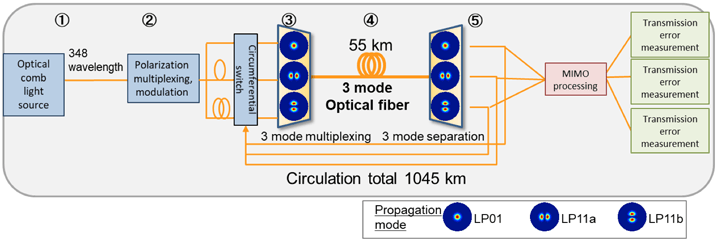Apr 17 2018
A three-mode optical fiber, with the ability to carry out wide-band wavelength multiplexing transmission with a standard outer diameter (0.125 mm) that can be cabled with prevalent equipment, has been developed by NICT Network System Research Institute and Fujikura Ltd. (Fujikura, President: Masahiko Ito).
 Schematic diagram of the transmission system. (Image credit: National Institute of Information and Communications Technology)
Schematic diagram of the transmission system. (Image credit: National Institute of Information and Communications Technology)
The company has successfully carried out a transmission experiment across a distance of 1045 km with a data-rate of 159 Tb/s. Multimode fibers include disparate propagation delays between optical signals in disparate modes, rendering it challenging to meet long-distance transmission and large data-rates at the same time. This success indicates that such drawbacks can now be overcome.
Conversion of the outcomes as the product of distance and data-rate, which is a general indicator of transmission capability, results in 166 Pb/s×km. This is the largest data-rate across 1000 km for any type of standard-diameter fiber and the world record in a few-mode optical fiber with standard outer diameter.
To accomplish the transmission capacity of 159 Tb/s, mode multiplexing used in conjunction with 16-QAM (quadrature-amplitude modulation) - a practical high-density multilevel modulation optical signal - for the entire 348 wavelengths and multiple-input and multiple-output (MIMO) allows unscrambling of mixed modal signals even after transmission across more than 1000 km. This demonstrates that multimode fibers with standard outer diameter can be used to communicate high-capacity optical backbone transmission systems.
The outcomes of this study were presented as a post-deadline paper on the prestigious 41st Optical Fiber Communication Conference and Exhibition (OFC2018), held in San Diego, United States, from March 11 to 15, 2018.
Background
To deal with ever-increasing communication traffic, studies on large-scale optical transmission with innovative types of optical fiber surpassing the limit of traditional optical fiber and its application have been actively performed across the globe.
The major innovative types of optical fibers under study are multicore fibers, where multiple passages, or cores, are arrayed in an optical fiber and multimode fibers supporting multiple propagation modes in a single core that has a larger core diameter. To date, successful large-capacity and long-distance transmission experiments have been carried out for multicore fiber; however, researchers considered that achieving transmission that met large capacity and long distance at the same time was challenging in multimode fiber.
Achievements
In this study, NICT developed a transmission system with the help of an optical fiber created by Fujikura and successfully transmitted across 1045 km at a data-rate of 159 Tb/s. Conversion of the outcomes as the product of distance and transmission data-rate—a general indicator of transmission capability—is 166 Pb/s×km, which is nearly twice the world record so far in the few-mode fibers.
The transmission system includes the following element technologies:
- Three-mode optical fiber with a standard outer diameter of 0.125 mm
- Separation technology of multimode optical signals with different propagation speeds in fiber (MIMO processing)
- 16-QAM multi-level modulation technology equivalent to 4 bits/single polarization symbol
- 348 wavelength optical comb light source
The researchers were successful in transmitting across 1045 km with the help of a standard three-mode optical fiber. While laying optical fibers with standard outer diameter, the prevalent equipment can be used and its practical use at an early stage looks promising. Moreover, ultimate large-capacity transmission will be feasible in the future when it is integrated with multicore technology, which is being studied by NICT in collaboration with university, industry, and government in Japan.
Future Prospects
The researchers will continue to study and develop future optical communication infrastructure technologies with the ability to smoothly accommodate traffic such as 5G network services and big data.
Reference
Georg Rademacher, Ruben S. Luis, Benjamin J. Puttnam, Tobias A. Eriksson, Erik Agrell, Ryo Maruyama, Kazuhiko Aikawa, Hideaki Furukawa, Yoshinari Awaji, and Naoya Wada, “159 Tbit/s C+L Band Transmission over 1045 km 3-Mode Graded-Index Few-Mode Fiber,” in Proc. 41st Optical Fiber Communication Conference and Exhibition (OFC), March 2018, paper Th4C.4.